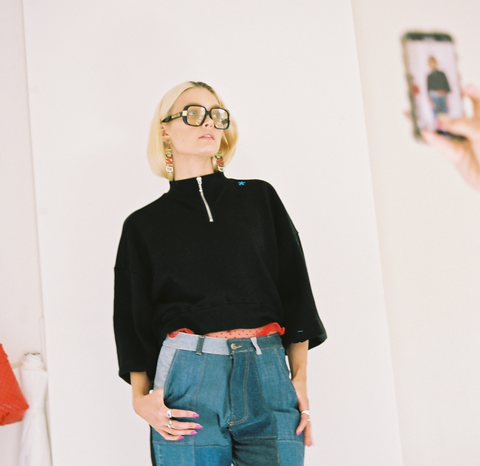Most days I have a paradoxical internal dialogue that argues with itself about the ethics of owning a fashion brand which creates new clothing.
The reason why I am perpetually in this moral conundrum is because I am contributing to the most prevalent and important problem on Earth; C02 emissions keep rising warming the planet at an ever increasing pace as biodiversity declines and water becomes scarcer. These are the horrific realities of climate change.
If you haven't already seen it, give David Attenborough's new documentary 'A Life on Our Planet' a watch on Netflix. Tissues and a notepad might be good company too!
So, here I am back in the riddle, with a strongly imbued sense of responsibility to utilise my platform to help educate my customers and fellow fashion consumers. To make informed and honest choices, and to know that when they purchase from a label such as ours, that they can have faith in both the products and decisions that we make on their behalf.
I am still learning every day, and I don't profess to be flawless or proclaim to be a sustainable brand. I recognise the inherent contradiction between the textile industry and sustainability; fashion at its core demands newness, and survives on the endless cycle of consumption.
But, this doesn’t need to always be the case. I promise to always exercise diligence and make the best decisions I can to minimise the impact of Après Studio's carbon emissions without compromising on our brand values; because the only thing you should emit are smiles and happiness when you wear our products.
Climate change is the most urgent global threat we face, and pressure is mounting on governments around the world to commit to robust measures to tackle the crisis. However when governments fail to pick up the slack, industry is there to lead the way.
The fashion industry is responsible for 10% of annual global carbon emissions, more than all international flights and maritime shipping combined. At this pace, the fashion industry’s greenhouse gas emissions will surge more than 50 % by 2030.

I have been designing and learning from the best in the industry for over 10 years now. I have worked for large international fashion houses that couldn't care less about their environmental impacts, and for other companies and brands that cared so much that their business was no longer viable or profitable.
I personally, am slowly growing tired of the consistent green washing our industry clings onto as a form of advertising and product promotion. Almost as if to dissipate the climate guilt you as a customer may carry by buying yet another item of clothing you actually can live without.
‘Greenwashing’ is when a company or organisation spends more time and money on marketing themselves as environmentally friendly rather than on actually minimising their environmental impact.
I personally believe that every business both big and small should be held accountable for their environmental responsibility and carbon footprint and for it to be proportional to their business size. This information would then be disclosed publicly, in order for their consumer to properly understand the reasoning behind brands selling their products at their formulated price point.
If the bigger brands demanded use of environmentally responsible fabrics, the supply would naturally increase. Increased supply would lead to increased availability of these fabrics which would drive the price point down due to market competition and make it an easier, more affordable choice for everybody.
Small steps for small businesses and bigger leaps for bigger brands.
Being a small brand myself, accessibility to organically certified fabrications and dyes and finishes are not only expensive, but generally carry a higher minimum order quantity due to the rigorous techniques engaged to produce the yarns, weave them into a fabric and control the outcome of the dyed colours.
The technologies often needed to create recycled fibres through mechanical processes are very expensive. These expensive, technology reliant machines then need to be paid off by the suppliers who use them and the price is absorbed across the price of these yarns. It is a very involved process to collect, break down, regenerate and weave these yarn fibres meaning the price point is yet again effected. If not done mechanically, it is an even more involved process as the original materials or fibres need to be chemically broken down into their molecular form and then reformed into new fibres. This process is both technically and economically challenging.
In the end you're looking at a very expensive fabric and time consuming process even before you have begun any designing, pattern making, grading, cutting, making, trimming, packaging, shipping, importing, freight, photo-shooting, marketing costs and time factored in.
At the end of the day, it's not environmentally responsible to be creating multiple products that nobody can afford to buy; they don't get bought, used, worn, loved, repaired and passed down. They instead, sit, unused and unloved in a warehouse.
This is the delightful paradox I wrestle with every season.
If we could all be naked all the time, I would totally embrace that!

Personally, I try to check back in with the point I pledge to prove -- that an environmentally responsible garment doesn't need to look dull, lifeless, lacking in strong direction and style.
It welcomes dressing as a form of self-expression. For me, dressing is a huge part of how I feel and that feeling is then projected to other beings, creating a collective consciousness and this is what I try to embody in my designs.
I try to make decisions and moral considerations on behalf of you, my customers, every time I develop something new so that you know that you are buying from an honest clothing brand grounded by ethics & respect for the environment. I want you to wear your Après Studio with pride, not only by the way you look but also by what you represent.

To help you understand a little more about our design considerations and processes, I have listed the below questions I ask myself and my makers:
+ What fabric is feasibly available to work with?
+ Can I find an affordable certified organic or recycled alternative with minimum order quantities below 100 yards?
+ Is the fibre known for properties such as durable, breathable, trans-seasonal, comfortable, renewable or biodegradable?
+ Will the fabric look good, feel good, drape well with minimal fuss for my customers? -- Who loves ironing? Not me!
+ Can you move your body easily / well in the clothing? Moving your body and feeling light and agile yet supported is so important.
+ Does the clothing have multiple wearing purposes?
+ Is it hard or easy to launder? Does it require dry cleaning? Dry cleaners often use dangerous chemical solvents that can stick to clothing. Most cleaners use perchloroethylene, also known as tetrachloroethylene, PCE, or perc. It is reasonably anticipated to be a human carcinogen
+ Does the design transcend trends, phases or fads?
+ Can I afford to produce this design that utilises this much fabric with these trims in my BSCI certified factory with all of these intricate details such as my signature coloured stitches and stars and bell sleeves? Does that price then translate to an affordable RRP?
+ Do my customers see the quality and the detail? Do they feel it? Do they feel amazing when they wear it? How do I feel when I wear it? Will this suit multiple body shapes and sizes?

OUR CURRENT RESPONSIBILITY PRACTICES
+ We do not adhere to traditional development schedules. We create clothing as we predict the demand for it emerging.
+ We open up pre-orders for our products to help eliminate over-ordering of stock.
+ We try to use organically certified fabrics and dyes as well as recycled fabrications whenever it is feasible / accessible to do so.
+ We create high quality clothing garments that are made to wash and wear and withstand the rigours of time, so you need to buy less and less frequently.
+ We use GOTS (Global Organic Textiles Standard) certified recycled cardboard boxes to ship our stock in.
+ We ship our stock via sea, not via air.
Airfreight leaves the largest freight carbon footprint. Airplanes emit 500 grams of CO2 per metric ton of freight per km of transportation, while transport ships emit only 10 to 40 grams of CO2 per kilometre.
+ We use recycled un-dyed / untreated tissue paper to wrap our orders in.
+ We use recycled plastic stickers instead of sticky tape.
+ We use home compostable mailers to send your orders to you, which can also be reused before composting.
RESPONSIBLE PRACTICES FOR OUR FUTURE
+ We have bought a lot of fabrication samples made from renewable resources that don't use a lot of water, chemical processes and electricity to manufacture. We are currently working on some new development utilising these fabrics.
+ The same fabric suppliers also use GOTS certified dyes that are free from chemicals and ensure the fabric is safe to biodegrade at the end of its life cycle.
+ We are developing an at home compostable alternative to plastic polybags which our makers are lawfully required to wrap each of our garments in before shipping.
+ We are negotiating with our manufacturers to try to implement a lower minimum order quantity so that we only make what is required. By implementing the above manufacturing practice, we eliminate the industry pressure to be on sale with stock that has been available to buy for 'too long'.
+ We have consolidated our overseas development trips into one large trip to do our entirety of development in one hit. Less c02 / flights = reduced carbon footprint.

Our ultimate ambition is to create a fashion collection that does no harm to the environment. No harm when it's produced, when it's consumed, or during its afterlife. This is super ambitious, highly complex and sometimes makes us look like we’re behind brands that simply switch all of their fabrics to organic alternatives overnight.
You could argue that the sole fact we produce for consumption means that we are not responsible and we totally understand your point of view.
But we still believe that fashion can be a force for good, and a vehicle for change. We also don’t think fashion is ever going to go away. But instead of shutting down our business, we'd rather go to work every day and focus on creating a responsible fashion industry.
We will continue producing lifestyle enhancing, supportive and stylish garments and accessories as best as we can whilst maintaining a high level of honesty.
If you ever have questions, please reach out to us info@apresstudio.com.au
With love, always,
Meg.
X







Comments (0)
There are no comments for this article. Be the first one to leave a message!